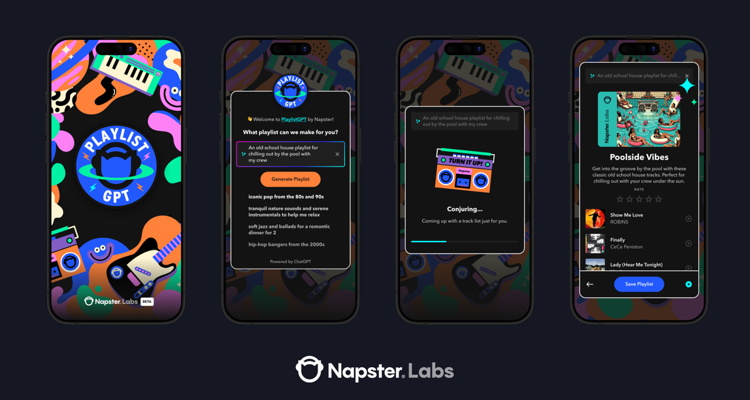Napster Embraces ChatGPT with New ‘PlaylistGPT’ Feature


Photo Credit: Napster
Napster is embracing generative AI with its new ‘PlaylistGPT’ feature, which allows anyone to create a playlist from a ChatGPT prompt. Here’s how it works.
Using the new PlaylistGPT feature on Napster allows users to type their idea as a ChatGPT prompt, which Napster converts into an AI-generated title, playlist, description, all featuring AI-generated artwork. The integration of ChatGPT and its DALL-E image generators marks the first time a digital streaming provider (DSP) has integrated these services.
Subscribers to Napster can save these playlists to their accounts for listening, while those who don’t subscribe can listen to 30-second song clips from the generated playlists. Napster CEO John Vlassopulos says the feature gives people the ability to turn recommendations into an actionable playlist. “The end goal for people is obviously to try and listen to the [generated] playlist, so we thought, why don’t we finish it?” he says.
While the playlists are AI generated, Vlassopulos says he believes this will open a new era of human curation of playlists. “The broader push is we want to be about people. The curators have gotten lost through the years in playlisting. This is allowing people to feel creative and put out something they are proud of and want to share. You can make it public, you can add tracks, take away tracks. It’s like a conversation.”
Jon Vlassopulos’ name may sound familiar, as he served as the Vice President & Global Head of Music at Roblox before jumping over to Napster in 2022. While at Roblox, he helped spearhead digital concerts with artists like Lil Nas X, David Guetta, Twenty One Pilots, and Zara Larsson. Vlassopulos says he plans to turn Napster into an artist-forward space that gives fans a place to celebrate their favorites.
“Every artist should have their own virtual space where they can drop singles, hang out, meet their fans, have digital goods, physical goods, talk about tours, and express themselves in their own unique way,” Vlassopulos concludes.
Link to the source article – https://www.digitalmusicnews.com/2024/02/02/napster-embraces-chatgpt-with-new-playlistgpt-feature/
Recommended for you
-
ROKIT 7 G4 7 inches Powered Studio Monitor (Renewed)
$198,76 Buy From Amazon -
Akai Professional MPC Studio Black | Ultra-Portable MPC With MPC Software (Download), USB Power, LCD Screen, Touch Sensitive Encoders, Brushed Aluminium Body & Data Dial
$349,90 Buy From Amazon -
KAISH Black Vintage Style Guitar AMP Amplifier Handle Vinyl PVC Handle with Accessories for FD Amplifiers
$13,99 Buy From Amazon -
Israel. Spirit of Israel – all original Multi-Layer Wav/Kontakt Samples/Loops Library
$14,99 Buy From Amazon -
CORNET 3 VALVE SILVER Bb FLAT PERFECT SOUND QUALITY + CASE & M/P
$117,00 Buy From Amazon -
DJI Mic (2 TX + 1 RX + Charging Case), Wireless Lavalier Microphone, 250m (820 ft.) Range, 15-Hour Battery, Noise Cancellation, Wireless Microphone for PC, iPhone, Andriod, Record Interview, Vlogs
$249,00 Buy From Amazon -
Otamatone [English Edition] Japanese Electronic Musical Instrument Portable Synthesizer from Japan by Cube/Maywa Denki, Black
$39,97 Buy From Amazon













Responses